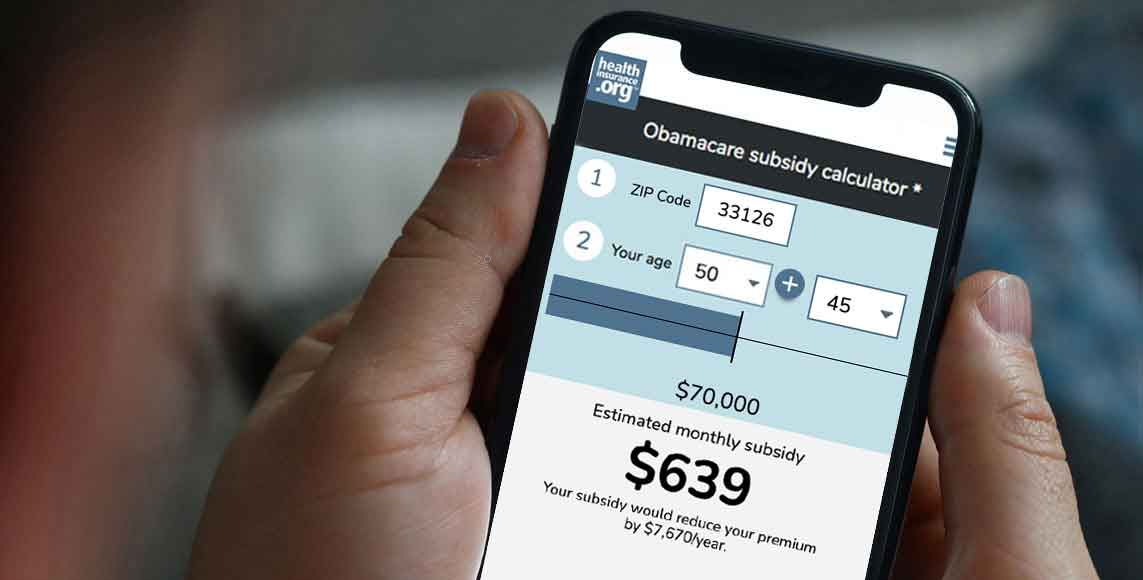Q. I’ve seen a lot of differing headlines about health insurance rates for 2021 – some say rates increased, some say they decreased, and now it all seems to have changed again as a result of the latest COVID relief legislation. Can you shed some light on this? And do these rate changes apply to everyone?
A. The vast majority of Americans get their health insurance either from an employer or from the government (Medicare, Medicaid, CHIP, TRICARE, VA, IHS). The rate changes that have been making headlines each fall for the last few years are for the individual market, which only accounts for about 6% of the population (and specifically, the ACA-compliant individual market; this is the vast majority of the individual market, but there are still some pre-ACA plans in that market, which have separate rate changes).
Obamacare subsidy calculator *
Estimated annual subsidy
$0
Do rate change headlines apply to all types of health insurance coverage?
When you see headlines about health insurance premium increases or decreases, the stories are typically about individual-market – and ACA-compliant – health insurance. The headlines usually aren’t referring to government coverage (although Medicare rate changes do typically generate some headlines each fall), employer-sponsored plans, or pre-ACA plans still in force.
- If you get your health insurance through your employer or from the government, the subsidies, exchanges, and the individual market health insurance rates that you’re seeing in media reports don’t apply to you. Employer-sponsored insurance rates change annually, and your employer will provide you with information related to your plan options for the coming year, including how your plan, premiums and/or cost-sharing might be changing.
- If you have Medicare, Medicaid, or CHIP coverage, you’ll receive information from the government or from your private insurer (if you’re enrolled in a Medicare Advantage, Medigap, Medicare Part D, or a Medicaid/CHIP managed care plan), letting you know how your coverage and/or costs might be changing for the coming year.
- If your health insurance plan is grandfathered or grandmothered, you’re in a separate risk pool from the ACA-compliant plans offered by your health insurer, which means your rate increases for the coming year won’t necessarily match the rate increases you might be seeing in media reports about ACA-compliant plans issued by your insurance company. (There’s no requirement that carriers continue to renew grandfathered and grandmothered plans. They can decide to cancel them instead, and replace them with ACA-compliant plans.)
Headlines about rate increases (or decreases)
If you have an individual/family major medical health insurance plan, purchased on-exchange or off-exchange, that became effective January 2014 or later, it’s compliant with the ACA. The annual rate changes for these plans have been making headlines for the last several years, but the actual rate changes that apply to each enrollee’s premiums differ significantly because there are so many factors involved.
Here are some things to keep in mind:
- When you see headlines about rate changes, they almost always apply to full-price premiums, before any premium subsidies are applied. But 86 percent of the people who get their coverage via the exchanges are receiving premium subsidies (and the majority of the entire individual market population has coverage via the exchanges). These subsidies make a huge difference in terms of how much people actually pay for their coverage and how much their after-subsidy premiums change from one year to the next.
- Average full-price premiums increased significantly in 2017 and 2018. But they increased by less than 3% in 2019, decreased slightly for 2020, and increased slightly for 2021. But that’s doesn’t mean the rate changes were uniformly small: Average rates increased by more than 10% in Indiana, and decreased by more than 13% in Maine (and again, that’s for people who pay full-price premiums; changes in after-subsidies premiums can be very different).
- CMS put out a press release in October 2020, noting that premiums in the exchanges were dropping for the third year in a row, and that benchmark premiums were decreasing by an average of 2% for 2021. This was widely reported in the media, but this 2% average rate decrease only applies to the average benchmark plans (second-lowest-cost silver plan) available via HealthCare.gov. That means it doesn’t apply to the vast majority of plans sold on HealthCare.gov, and it doesn’t apply to any of the plans sold in the 15 fully state-run exchanges.
- You might have seen articles about very stable overall rates for 2021 — on the heels of rates that have been quite stable ever since 2018. Or about significant rate increases in places like Indiana. Or about significant rate decreases in Maine and Maryland. And sometimes, rates can decrease for people who don’t get premium subsidies while simultaneously increasing for people in the same area who do get premium subsidies. It’s no wonder people are confused.
How does the American Rescue Plan affect premiums for 2021?
For many people who buy their own health insurance, the American Rescue Plan (ARP) will make coverage more affordable in 2021 than it would otherwise have been. Most people who are receiving unemployment compensation in 2021 are eligible for $0 premium benchmark plans with robust cost-sharing reductions. And for 2021 and 2022, the “subsidy cliff” has been eliminated and the percentage of income that people have to pay for the benchmark plan has been reduced.
This comparison chart shows some examples of how the new rules result in increased premium subsidies for many enrollees, and lower after-subsidy premiums. The specifics will vary from one enrollee to another, since premiums depend on age and location. But in general, premiums for many enrollees are more affordable now that the American Rescue Plan has been enacted. The ARP’s additional subsidies are retroactive to January 2021 for people who have been enrolled in marketplace plans all year. They can be claimed on 2021 tax returns, or enrollees can log back into their marketplace accounts in the coming months and follow the instructions for a subsidy redetermination so that the additional subsidies can be applied to their accounts in realtime.
What's the biggest factor when it comes to premium increases?
The biggest factor is whether or not you get premium subsidies. If you don’t get a subsidy (which is the case for about 14% of exchange enrollees nationwide – plus everyone enrolled in off-exchange plans), your rate changes are pretty straightforward and just depend on how much your insurer is changing the premium for your plan next year (note that under the American Rescue Plan, some people who aren’t normally eligible for subsidies, including some with income over 400% of the poverty level, are eligible for subsidies in 2021 and 2022).
But if you do get a subsidy, your rate change depends on multiple factors: How much your plan’s price changes, how much your area’s benchmark plan price changes (keeping in mind that the benchmark plan isn’t necessarily the same plan from one year to the next), as well as things like changes in your income and family size.
Because average benchmark premiums decreased for 2021, average premium subsidies were initially a little smaller in 2021 than they were in 2020 (but the American Rescue Plan has increased subsidies fairly significantly for 2021 and 2022). And since the average benchmark premiums have decreased three years in a row, average premium subsidies have also decreased three years in a row (again, this is no longer the case for 2021, now that the ARP has been enacted). But that doesn’t mean your subsidy is smaller, since there’s a lot of variation from one area to another, and because your specific subsidy also depends on your own income, which can change from one year to the next.
And it’s important to keep in mind that although average benchmark premiums (on which subsidy amounts are based) decreased slightly for 2021, average premiums across the whole individual market increased slightly. So it was common for 2021 to see people who get premium subsidies ending up with an small overall average increase in their premiums for 2021 – assuming they weren’t enrolled in the benchmark plan in both years (the subsidies are designed to closely offset rate changes for the benchmark plan) or willing to switch to a lower-cost plan for 2021 (again, this is different now that the ARP has been enacted, with most enrollees now eligible for a larger subsidy than they got in 2020).
If you’re in an area where the benchmark premium decreased significantly, you may have found that your after-subsidy premium ended up increasing significantly, which can be disconcerting after you’ve seen headlines about rate decreases. This is what happened in some parts of Colorado in 2020, for example. And it can also happen in areas where a new insurer moves into the area and undercuts the previous benchmark plan; there are at least 20 states with new insurers for 2021 and numerous other states where existing insurers expanded their coverage areas.
Can you avoid health premium increases?
No matter what, you need to carefully compare your options when you enroll. If you’re eligible for a premium subsidy, you need to shop in the exchange in your state. (Use our calculator to get an idea of whether you’re subsidy-eligible – it only takes a minute to find out. And make sure you understand what counts as income under the ACA and how you might be able to adjust yours to make yourself eligible for a subsidy.)
And if you currently have a plan you purchased outside the exchange, be sure to double-check your on-exchange options for next year before deciding whether to renew your off-exchange plan. People with off-exchange plans should carefully consider the on-exchange options during the COVID-related enrollment window in 2021, as they may find that they’re newly eligible for premium subsidies as a result of the American Rescue Plan.
Even after 2022, when the ARP’s subsidy enhancements are slated to end (assuming they’re not extended via additional legislation), it’s important to check on-exchange options each year before deciding to renew an off-exchange plan. As the poverty level numbers increase each year, the limits for subsidy eligibility go up as well. In 2014, a family of four had to have a household income of no more than $94,200 in order to get a subsidy. For 2020, that had grown to $103,000. There is no income limit for subsidy eligibility in 2021 and 2022, thanks to the ARP. But if and when an income limit is reinstated in 2023, it will have increased from the level that applied in 2020.
If you have a grandmothered or grandfathered plan and your insurer is letting you renew it, be sure to carefully compare it with the ACA-compliant options that are available to you. Consider the benefits as well as the premiums, and know that you’ll also qualify for a special enrollment period during which you can pick an ACA-compliant plan to replace your existing coverage, instead of renewing it.
So did health insurance premiums increase for 2021?
The answer is … it depends. It depends on where you live, what plan you have, whether you changed plans during open enrollment, and whether you get a premium subsidy. And if you do get a subsidy, there are several variables that go into how much your rates might have changed.
So ignore the headlines. Each year, focus on the plans that are available to you and see how your premium and out-of-pocket costs might change if you select a different plan versus keeping the one you have.
Thanks to the ACA, you have the option to shop from among all of the available plans in your area each year, regardless of whether you have health conditions or not (prior to the ACA, people in most states had limited access to new health plans in the individual market if they had pre-existing conditions).
The initial transition to ACA-compliant plans
The ACA makes health insurance available to anyone who applies (no more underwriting rejections or rate-ups) and subsidizes the cost for people who need it the most.
Some people who don’t get a premium subsidy saw sharp rate increases in 2014, with the transition to a guaranteed-issue market and plans that cover the essential health benefits. But even among people who pay full-price for their coverage, some enrollees may have experienced a rate decrease when they switched to an ACA-compliant plan, even without a subsidy. That could be the case for a variety of populations:
- If they already opted for a very comprehensive, low-deductible plan prior to 2014, they may have been able to find coverage in the exchanges that wasn’t significantly more expensive than what they paid prior to 2014.
- If they had an underwriting rate-up on their pre-2014 plan, the new plans might have been a less-expensive alternative. Although the standard rates for ACA-compliant plans were higher than the pre-2014 base rates, there’s no additional charge for people with pre-existing conditions. Prior to 2014, that was not the case. People with pre-existing conditions were often charged rates that were at least 25 percent higher than the base rates, and sometimes 100 percent higher.
- Older applicants get a better deal than they used to prior to 2014. Rates for older enrollees are limited to three times the rates for young enrollees under the ACA, which is a dramatic shift from the pre-ACA ratios that often ran as high as five to seven times as much for an older applicant.
Who's paying more? Who's paying less?
There are some people who are paying quite a bit more for their health insurance now that the ACA has been implemented: primarily enrollees who are younger, healthy, had plans with high out-of-pocket exposure prior to 2014 (potentially higher than the ACA now allows, like a $10,000 individual deductible, for example), and also have incomes high enough to make them ineligible for subsidies.
However, there are plenty of people who are ineligible for subsidies who don’t fall into those other categories. For them, there hasn’t been as much in the way of “rate shock” over the last several years, and they might have ended up with a better deal starting in 2014, even without accounting for subsidies. It’s also important to note that it’s been more than a decade since the ACA was enacted. Premiums in the individual market had already been increasing steadily for years before that, so the premiums from 2009-2013 would be long gone by now, even without the ACA’s changes.
Louise Norris is an individual health insurance broker who has been writing about health insurance and health reform since 2006. She has written dozens of opinions and educational pieces about the Affordable Care Act for healthinsurance.org.












